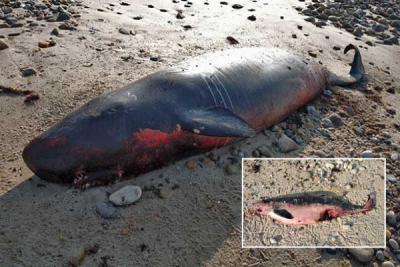Nature Notes: More Whales Lost

On Wednesday an odd couple, mother and near neonate, sadly washed up on the Shagwong beach west of Montauk Point near the opening to Oyster Pond. No unidentifiable Montauk Monster this time, but rather two very identifiable pygmy sperm whales as per Victoria Bustamante’s photographs. Both were bloodied and, apparently, both had already been host to several turkey vultures hanging around that area.
Vicki, her son Chris and his girlfriend, Rachel, and friend Fabian had heard about one of the two whales and when they went to the beach to look, a little more than a stone’s throw from the Bustamante house there were two, cow and calf. A very sad scene indeed.
A pygmy sperm whale or its very close cousin, the dwarf sperm whale, washes up on a South Fork beach every 10 years of so. They are nowhere common, but like the osprey, are found throughout the world. They are very seldom seen, as they tend to retreat, skulking just below the surface, part of their backs exposed, or sinking into the depths off the continental sea shelf to escape notice or feed. They are solitary, paired, or travel in small groups, no more than six to a pod, unlike the third specie in the genus, the giant sperm whale, which is bold and aggressive and travels in large pods, the same species upon which the famous American novel “Moby Dick” was based.
These three whales belong to the tooth-whaled group; they have up to 24 teeth in their lower jaw which have a raking or sieving function in feeding. All three of them feed on squid, the big one able to take a giant 300-pound squid in one gulp.
The toothed whales also differ from the baleen whales in that they have only one functioning blowhole for expelling water and breathing in air. Blowholes derive from the nostrils of ancestral land mammals (as the very early hippopotami). Baleen whales have two. The other nostril of in the toothed whales is covered over, and in becoming so, has changed its function. It is used to produce the sounds used in these whales’ very accurate echolocation, sounds that are then amplified by the spermaceti sac and the “melon” of the forehead and emitted in a directional beam of clicks via the functional blowhole. The clicks are in the pitch range of 125 kilohertz, way above the human ear’s detection limit.
The spermaceti is made up of a waxy mixture of oils and greases. When sperm whales were harvested during the whaling years, it was used to make lubricating oils and candles, which were much in demand throughout the world.
The pygmy sperm whale is no match for a big shark or an orca, and so it resorts to another defensive device not found in other whales or porpoises. It stores up gallons of reddish-brown liquid in its intestine and, when threatened, exhales it through its blowhole to confuse a potential predator while it slowly slips away from its grasp. Not only does it feed on squid and octopi, it employs their defensive strategy when it becomes a prey.
The pygmy sperm whale is adept at staying out of trouble and identifying prey and potential enemies using directional sound, and it also has magnetic crystals in its snout, which are believed to be used in homing and directional navigation. The common pigeon is another species that seems able to use the earth’s magnetism to find its way in the dark or over a long course.
The gestation period of the female pygmy sperm whale is about 11 months, and the single young is believed to stay in the care of the mother for more than a year before weaning. Pygmy sperm whales do not take well to captivity, seldom lasting for more than a month or so when put in an aquarium.
Meanwhile, the crew from the Riverhead Foundation for Marine Research and Preservation was on the job autopsying the whales, one of which was to be buried on the Montauk beach. It provided exact measurements, 9.7 and 4.5 feet long, respectively, according to Rachel Bosworth, a spokeswoman for the foundation. It will be interesting to see if the two had plastic in their stomachs, a common finding during such autopsies of cetaceans.
Interestingly, the National Oceanic and Atmospheric Admistration, which is charged with protecting marine mammals in the United States, and the United States Fish and Wildlife Service and Coast Guard are busy working with several private not-for-profit organizations to protect whales and increase their populations, while other branches of the federal government are trying to open pelagic waters to oil wells, wind turbines, and increased traffic by big ships plying the Atlantic and Pacific. Then, too, there is the Navy, with its constant sonic underwater booming, which is harmful and disorienting not only to whales but also to porpoises, orcas, seals, sea lions, walruses, marine turtles, and fish with swim bladders, of which there are thousands.
Every time such a tragedy besets us, and they are becoming more and more common with each passing year, we have to ask our government, which will it be? Conserve the marine mammals according to the legislative acts on the books, or, conversely, make it more and more difficult for them to carry on their life functions by continuing to allow the oceans to be exploited by industry and profiteers?
Larry Penny can be reached via email at [email protected].
